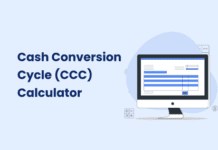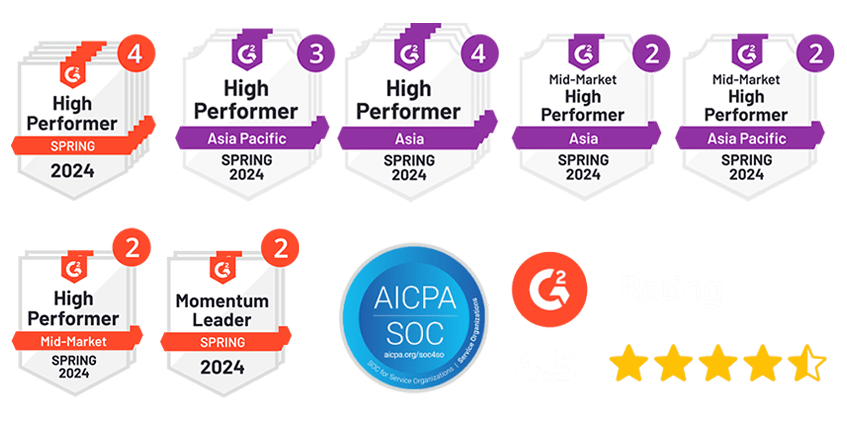Imagine your business as a bustling city with various roads and intersections. In this vibrant city, cash flow is the heartbeat, the circulation that keeps everything alive and moving. Whether it’s a small startup or a large enterprise, understanding and managing cash flow is crucial for the survival and growth of the business.
In this blog, we’ll stroll through the streets of cash flow, exploring why it matters, how to calculate it, and strategies to keep the cash flowing steadily.
What is Cash Flow?
Cash flow is a measurement of the amount of money that flows in and out of the company during a specific time period. Cash received indicates inflows, and the money spent represents outflows.
The formula to calculate net cash flow is as follows:
| Net Cash Flow = Total Cash Inflow – Total Cash Outflow |
Cash flow can either be positive or negative. Positive cash flow occurs when money entering your company is more than the money going out. A negative cash flow means that the expenses exceed your cash inflow.
Why Cash Flow Matters?
Think of your business as a well-oiled machine. While sales and revenue are fuel, cash flow is the lubricant that keeps all the gears running smoothly. Without steady cash flow, even the most successful businesses can hit roadblocks.
Let’s delve into why cash flow is important:
- Sustain Day-to-Day Operations: Steady cash flow ensures you can pay your bills, salaries, and other operational expenses on time.
- Allow Growth Opportunity: Healthy cash flow allows for strategic planning and provides the flexibility to invest in growth opportunities, such as expanding product lines or entering new markets.
- Prepare for Emergencies: Positive cash flow is essential for businesses to navigate unexpected challenges without compromising operations.
Types of Cash Flow
Cash flow is the net amount of cash a business generates from its operating, investing, and financing activities. Here’s a quick breakdown:
Cash flows from operations
It includes the cash generated or used in day-to-day business operations. Think of it as the cash generated from sales, payments from customers, and cash paid for expenses like rent and salaries.
Cash flows from investing
It relates to cash transactions for buying and selling assets. The purchase of securities or sale of assets are the transactions that fall under investing activities.
Cash flows from financing
It involves transactions with your business’s capital and debt. If your business takes out a loan or pays dividends to shareholders, these activities affect your cash flow.
Cash Flow Analysis: Unveiling Crucial Ratios
Analyzing a company’s cash flow provides invaluable insights into its financial health, visibility into current earnings, and future cash flow projections. Here are some key ratios to consider while performing cash flow analysis:
Free Cash Flow (FCF):
It represents surplus cash available after capital expenditures. The FCF signifies a business’s efficiency in generating profits from invested capital.
| Formula: FCF = Operating Cash Flow – Capital Expenditures |
Operating Cash Flow (OCF):
OCF is the percentage of revenue converted into operating cash flow. A higher margin indicates efficient operations.
| Formula: OCF Margin = (Operating Cash Flow / Total Revenue) * 100 |
Cash Return on Assets (CROA):
CROA measures how effectively a company utilizes its assets to generate cash flow.
| Formula: CROA = Operating Cash Flow / Average Total Assets |
Cash Flow to Debt Ration:
It evaluates a company’s ability to repay debt using operating cash flow.
| Formula: Cash Flow to Debt = Operating Cash Flow / Total Debt |
Comprehensive Free Cash Flow Coverage:
It is the percentage of FCF over net operating cash flow. A higher percentage indicates better financial health.
| Formula: Comprehensive Free Cash Flow Coverage = (Free Cash Flow / Net Operating Cash Flow) × 100 |
Current Liability Coverage Ratio:
It is the ratio of cash flow from operations to current liabilities. A ratio below 1:1 raises liquidity concerns.
| Formula: Current Liability Coverage Ratio = Cash Flow from Operations / Current Liabilities |
Price to Cash Flow Ratio:
It is the ratio that measures the value of a stock’s market price relative to its last reported cash generated by the company.
| Formula: Price to Operating Cash Flow = Stock Price / Operating Cash Flow per Share |
Cash Flow Margin Ratio:
It is the ratio of cash flow from operations to sales. It quantifies efficiency by indicating sales generated per dollar.
| Formula: Cash Flow Margin Ratio = Operating Cash Flow / Net Sales |
Cash Flow to Net Income Ratio:
It is the ratio of net cash flow to net income, with a 1:1 ratio considered ideal.
| Formula: Cash Flow to Net Income Ratio = Net Cash Flow / Net Income |
Cash Conversion Cycle:
The cash conversion cycle is the metric that measures the total time taken to convert sales into cash.
| Formula: Cash Conversion Cycle = Days Inventory Outstanding + Days Sales Outstanding – Days Payable Outstanding |
Dividend Payout Ratio:
Indicates the proportion of earnings distributed as dividends, offering insights into a company’s dividend sustainability.
| Formula: Dividend Payout Ratio = Dividends / Net Income |
These ratios, alongside the cash flow statement, give us a detailed picture of a company’s financial health. They serve as invaluable tools for making data-driven strategic decisions.
How to Manage Cash Flow?
Following are some of the best practices for managing cash flow effectively:
- Plan ahead by creating a budget outlining your expected money inflows and outflows.
- Have a safety net of cash reserves for unexpected expenses or lean periods.
- Keep a close eye on where your money is going to identify areas for optimization.
- Cut unnecessary costs and find ways to make your spending more efficient.
- Explore avenues to increase sources of income to bolster your cash flow.
- Avoid excess inventory that ties up cash; maintain a balance to meet demand.
- Streamline your finance operations to ensure effortless cash flow management.
If you’re eager to dive deeper into the art of effective cash flow management, check out our blog for more insights!
Cash Forecasting Trends in 2023 and Beyond: Embracing AI for Dynamic Insights
As we navigate the future of cash flow management, the integration of AI stands out as a game-changer. AI-powered solutions are reshaping financial landscapes by generating dynamic reports for Accounts Receivable, Accounts Payable, and Cash Forecasting. These solutions offer real-time, data-driven insights, thus enhancing decision-making processes. With predictive analytics and automation, businesses can proactively address cash flow challenges, optimize working capital, and ensure financial resilience. In 2023 and beyond, leveraging AI is not just a trend; it’s a strategic imperative for those seeking to stay agile and thrive in the ever-evolving economic ecosystem.









![Why AI Sales Calls Are Making Good Sales Reps Even Better [2025 Guide] ai sales calls](https://cdn-kmjmp.nitrocdn.com/YvtqmrsiHUxqerlSiZgbfzqqTARWTElr/assets/images/optimized/rev-834053b/blog.peakflo.co/wp-content/uploads/2025/09/65168cf6-3001-4733-8cbc-12d5684cf449-218x150.webp)

































